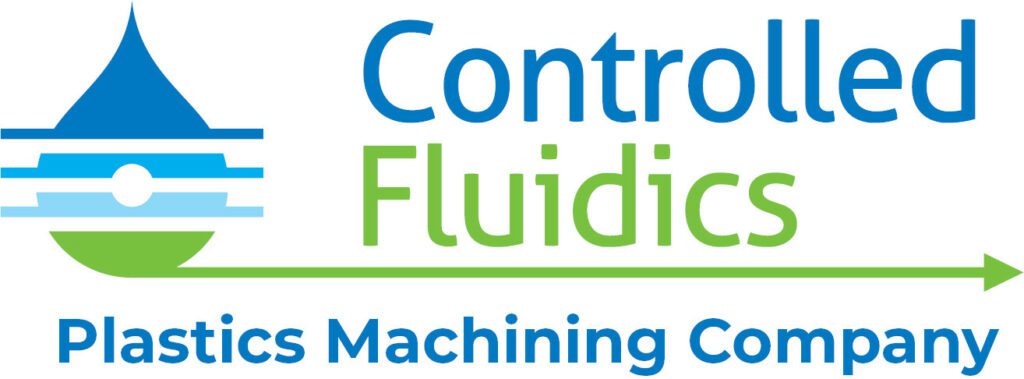Polycarbonate Plastic Manifolds (Podcast)
In this podcast, Tom Rohlfs talks about the benefits of polycarbonate manifolds. He outlines its chemical and thermal resistance. Then, he talks about other advantages and covers some common applications.
John Maher: Hi, I am John Maher. I’m here today with Tom Rohlfs, President and Principal Engineer at Controlled Fluidics, a plastics machining company specializing in precision manifolds.
Our topic today is polycarbonate plastic manifolds. Welcome, Tom.
Tom Rohlfs: Hello, John. Good afternoon. Thanks for having me.
What Is Polycarbonate?
John: Sure. So Tom, what is polycarbonate?
Tom: Sure. Polycarbonate material is in the same class of materials like acrylic and Ultem. It’s an amorphous material. It means it’s clear, generally clear. Its chemical structure is similar to a bowl of spaghetti as water passes through it. It’s one of the materials that we bond manifolds with. It’s a cousin to acrylic and Ultem in that regard, and it has particular advantages over other materials.
Characteristics of Polycarbonate
John: And in terms of its characteristics in the use of manifolds, what are some of its characteristics? You mentioned that it’s clear. Do you have anything else?
Tom: Oh yeah, sure, of course. So what’s interesting about polycarbonate is… we’ve talked in the past about acrylic. Acrylic is our number one material in particular because it’s low cost and has great clarity and scratch resistance. Polycarbonate is similar in clarity, has a little bit of a light tint, but its advantages over acrylic is that it’s much more thermally and chemically resistant.
Interestingly enough, it’s only about 10 to 20% more expensive than acrylic, but you get significantly more thermal capability up to roughly 225 degrees Fahrenheit continuous service temperature. And it’s good for alcohol related processes. So oftentimes customers will want to run reagents and then do a cleaning procedure. Well, polycarbonate can tolerate ethanol, methanol, isopropyl, the alcohols quite readily in comparison to acrylic which would have a stress cracking failure in that regard.
Advantages of Polycarbonate for Manifolds
John: So what are some of the advantages and disadvantages of using polycarbonate plastic for manifolds? You mentioned it being thermally and chemically resistant. Can you talk about that a little bit more?
Tom: Yeah, sure. As we mentioned, it’s not that much more expensive than acrylic, but you do get higher performance. Oftentimes, liquid manifolds don’t work well with acrylic because it just doesn’t have the chemical resistance.
Polycarbonate gives you that chemical resistance to a lot of known solvents without really adding a lot of cost, not going up to that level of Ultem, which we can talk about later. So that’s really nice. It’s in a nice spot with stronger capabilities at slightly greater cost.
It is available as a USP Class VI material. This is something that our customers look for as well. USB Class VI material is a medical-grade material. Generally, it’s allowable for fluid contact, blood contact, skin contact, not implant grade, but all the things that a device, an IBD device, a life science device would need. They want to be certain that there’s no toxicity to the human body and to the human body fluids, and that USP Class VI certification does allow that.
One of the downsides to polycarbonate being that it is an amorphous material, it is softer than acrylic, so it does scratch quite easily. It can be polished readily, but it’s quite soft. It’s a tough material, much tougher than acrylic. It doesn’t have that brittleness about it. It’s great. It’s an impact material. You can hit it with a hammer. But because of that softness handling can be an issue, and unfortunately, it does scratch relatively easy. So caution about rubbing things against it to maintain clarity is important.
Applications for Polycarbonate
John: Okay. And then what are some of the uses of polycarbonate plastic manifolds, particular industries or uses for it?
Tom: Yeah, sure. So in particular with polycarbonate, we start looking at, instead of pneumatic manifolds, we’re starting to look at liquid manifolds. So any of the life sciences devices that require reagent processing are great fit for polycarbonate.
Again, using methanol, ethanol, the alcohol flushes, it’s great, it fits nicely in that space without being too expensive above the acrylic manifolds. We find that Control Fluidics is one of the few companies that specializes in making polycarbonate manifolds. Our customers really appreciate that option instead of going up to the more expensive Ultem choices. So it’s a really nice fit into that life sciences space.
Contact Controlled Fluidics About Your Next Project
John: All right. Well that’s really great information, Tom. Thanks again for speaking with me today.
Tom: You’re welcome. Take care.
John: And for more information, you can visit the website at controlledfluidics.com or call (603) 673-4323.
